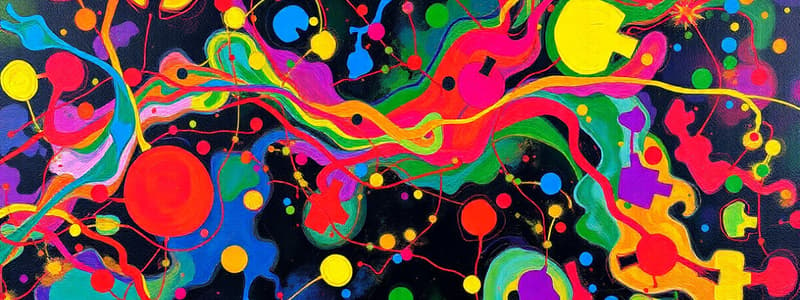Podcast
Questions and Answers
Which of the following statements accurately describes the role of PS II in non-cyclic photophosphorylation?
Which of the following statements accurately describes the role of PS II in non-cyclic photophosphorylation?
- PS II absorbs light energy and passes it to PS I, initiating the flow of electrons.
- PS II splits water molecules, releasing electrons, protons, and oxygen. (correct)
- PS II directly produces ATP using light energy.
- PS II reduces NADP+ to NADPH + H+ using the electrons from PS I.
What is the primary function of cyclic photophosphorylation?
What is the primary function of cyclic photophosphorylation?
- To reduce NADP+ to NADPH + H+ using electrons from PS I.
- To replace electrons lost by PS II during non-cyclic photophosphorylation.
- To generate a proton gradient across the thylakoid membrane. (correct)
- To synthesize both ATP and NADPH + H+
Why is ATP required in the Calvin cycle?
Why is ATP required in the Calvin cycle?
- ATP is used to activate RuBP, the primary carbon dioxide acceptor. (correct)
- ATP is used to generate NADPH + H+.
- ATP is used to reduce carbon dioxide to glucose.
Which of these conditions would favor cyclic photophosphorylation over non-cyclic photophosphorylation?
Which of these conditions would favor cyclic photophosphorylation over non-cyclic photophosphorylation?
The chemiosmotic hypothesis explains the mechanism of ATP synthesis by:
The chemiosmotic hypothesis explains the mechanism of ATP synthesis by:
Flashcards
Photophosphorylation
Photophosphorylation
The synthesis of ATP from ADP in chloroplasts using light.
Non-cyclic photophosphorylation
Non-cyclic photophosphorylation
Process where PS II and PS I operate together, producing ATP and NADPH.
Cyclic photophosphorylation
Cyclic photophosphorylation
Only PS I operates; electrons cycle back, producing only ATP.
Chemiosmosis
Chemiosmosis
Signup and view all the flashcards
Z Scheme
Z Scheme
Signup and view all the flashcards
Study Notes
Light Reaction (Photochemical Phase)
- Photophosphorylation is the synthesis of ATP in cells (mitochondria and chloroplasts).
- Photophosphorylation happens in two ways:
- Non-cyclic:
- Two photosystems (PS II and PS I) work in a series.
- Electrons travel through an electron transport chain (Z scheme).
- ATP and NADPH + H+ are produced.
- Electrons lost by PS II do not return to PS II, but move to NADP+.
- Cyclic:
- Only PS I is functional.
- Electrons are circulated within the photosystem.
- ATP is produced, but not NADPH + H+.
- Occurs in stroma lamellae.
- Occurs when light wavelengths beyond 680nm are available
- Non-cyclic:
Chemiosmotic Hypothesis
- Explains the mechanism of ATP synthesis in chloroplasts.
- Chemiosmosis: The movement of ions across a semipermeable membrane (chloroplast and mitochondria).
- Chemiosmosis requires a membrane, a proton pump, a proton gradient, and ATP synthase.
- Water splitting occurs on the inner side of the membrane, accumulating protons in the thylakoid lumen.
Studying That Suits You
Use AI to generate personalized quizzes and flashcards to suit your learning preferences.
Description
This quiz covers the light reaction phase of photosynthesis, including photophosphorylation and the chemiosmotic hypothesis. Learn about the mechanisms of ATP synthesis in chloroplasts and the roles of photosystems. Test your understanding of cyclic and non-cyclic processes in energy production.




